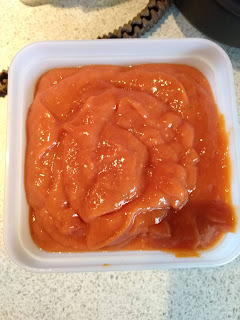At the end of the tomato growing season, it is time to pick the remaining green and red fruits for eating and preserving before cleaning out the polytunnel/greenhouse. Green and reddish-green tomatoes can be stored on a windowsill to ripen and then eaten in salads, etc. Check the fruits every other day, discarding any that do not look right, and you should be eating fresh tomatoes well into November.
Green tomatoes can be made in chutney or cooked while the ripe tomatoes can be processed for freezing to be used later in the year.
If you are in a rush, just open-freeze the tomatoes and pack into bags/boxes for later use; after defrosting the skins are easy to remove. I prefer to oven-roast the toms first because the flavour is better and more concentrated. Wash the tomatoes, discarding any 'bad' ones, slice in half and place on a tray:
Bake in the oven (160 ℃, fan oven) for about 1 hour or until the skins start to blacken. I will normally have 3 or 4 trays in at the same time. Remove from the oven and allow to cool:
Pick off the skins (I use my fingers):
The skins go in the kitchen compost caddy on their way to the compost bins.
Deskinned roasted toms can be boxed up, as is, or blended into a sauce before transferring to the freezer in bags or boxes.
Use in pasta sauces, curries, soups or as pizza toppings.
If there is a surplus of other vegetables from the garden then I will prepare a flavoured tomato sauce; for example:
1 L oven-roasted tomatoes
500 g courgettes (or peeled deseeded marrow)
3 tbsp bouillon powder (Marigold, Vegan)
1 tbsp dried oregano
2 cloves garlic
1 small red onion
4 sticks celery
Blend and freeze in the usual way.
The early part of the year was cold so the glasshouse crops were slow to get going. Even so, we enjoyed fresh tomatoes from June 22 to mid-November and have enough frozen tomatoes to last until late spring.
Carbon Footprint
Tomatoes grown locally in an unheated greenhouse/polytunnel have a low carbon footprint with the added benefit of tasting better than shop-bought ones. You should try to avoid buying out-of-season tomatoes grown in hothouses where the artificial heat is provided by fossil fuels (10-20 times higher carbon footprint). Tinned (or home-grown frozen) tomatoes are a better option in winter as far as their carbon footprint is concerned. If you want to buy fresh tomatoes out-of-season then opt for those grown in warmer countries that are not too far away; e.g. Spain and Morocco for the UK. Specialist tomatoes (cherry, plum, beefsteak, etc) have a higher footprint because of lower yields compared with the classic salad tomato. Of course, this shouldn't stop you from growing these specialist types in your own unheated greenhouse!













0 comments:
Post a Comment